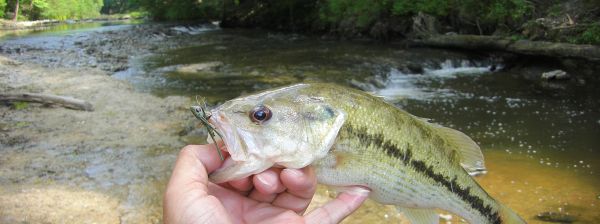
Cooler days bring hot stream action
This September marks the 32nd anniversary with the other love of my life — fly fishing.
From the time I inherited my maternal grandfather’s fly rods as a boy until the time I was in graduate school at LSU, the rods mostly gathered dust.
Then in the fall of 1981, my fishing buddy Terry Angelich inquired about the numerous streams he’d encountered driving north and east of Baton Rouge. Our curiosity led us to the Geology Department library, where we probed topo maps like the NSA probes emails.
We were looking for bridge crossings. Back then, nearly every bridge offered public access. From there one could walk the sandbars or wade the streambeds, or even launch a canoe.
On our first trip, I brought along the fly tackle. My grandfather and his brother had fly-fished for spotted bass in several of these Florida Parishes waters. They always caught lots of bass. Practicality was as much a factor as tradition.
It was a wise decision. Many aggressive spotted bass rose to the popper that day. Some would glance and turn back. But others would slurp it up, and then use the current to their advantage to make dogged runs that bent my fiberglass fly rod like a noodle.
This day was the start of my conversion from the Dark Side of the Fishing Force.
Over time, I learned that I could greatly improve my luck on these streams by applying some of the tactics that coldwater trout anglers use. For example, fishing is more productive upcurrent than downcurrent, since the fish are less aware of your presence.
Another key to success is maintaining a drag-free float when using poppers. A drag-free float is difficult because a stream has different speed currents across its width. Most often, the current in the middle is faster than along the edges.
Using a cast known as the “Reach Mend” allows you to place the fly line slightly upcurrent from the fly and leader. This gives your fly more time in the strike zone.
Other casts such as the “Steeple Cast” and the “Wiggle Cast” also allow for a drag-free float by introducing some slack into the presentation.
If you do a YouTube search for “Steeple Cast,” “Wiggle Cast” and “Reach Mend,” you’ll find a couple dozen good videos that demonstrate these techniques.
Your tackle selection for these waters should be at least a 4- or 5-weight rod, usually 7 ½ to 8 ½ feet long. Anything lighter is not recommended — spots are strong for their size, and these streams are riddled with washed-out trees. Get the picture?
Leaders should be less than 8 feet. Anything longer just makes for tough casting in tight cover.
The primary diet of spotted bass consists of insects, minnows and crawfish, so a variety of patterns will work. These include poppers, woolybuggers, fluff butts and gurglers. One of my friends favors the Pistol Pete — a woolybugger with a tiny spinner blade on the front.
I typically go poppers only. There’s nothing like watching fish rise to a fly. The other common inhabit of these waters — longear sunfish — also love poppers. Some of these longears grow to 8 inches. Living in moving water makes them even stronger, and thus their nickname, “killer gobbules.”
Spotted bass can be found in hilly streams across Louisiana. A number of these waters are designated as Scenic Rivers. Maps and other information on Scenic Rivers can be found at the Louisiana Department of Wildlife and Fisheries website (www.wlf.louisiana.gov).
The biggest obstacle to stream fishing is public access. The old tradition of parking near a bridge and recreating on the water below can often result in a visit from a sheriff’s deputy. But thanks to state and local governments, the future of public access looks brighter.
The Office of State Parks is continuing to look for access to scenic streams to satisfy the rapidly growing popularity of paddling. Bogue Chitto State Park near Franklinton is one example. Paddlers will find great fly fishing opportunities from the park down to Highway 437.
If you live in St. Tammany Parish, the river park on the Bogue Falaya in Covington is a great place to wade or launch a paddlecraft.
For most of my adult life, Baton Rouge has been my home. Here, the Recreation and Park Commission for the Parish of East Baton Rouge’s BREC provides access to the Comite River at Blackwater, Comite River and Plank Road parks. In the works is a kayak trail development at the new Frenchtown Road Conservation Area. This park will give paddlers and anglers 3 miles of access on the Amite River and 1 ½ miles on the Comite.
Earlier this year, we moved to the Kisatchie National Forest west of Alexandria. I’m now closer to an old friend — Kisatchie Bayou.
This stream is unique to Lousiana: It rises from a 500-foot elevation above Leesville and flows northeast across the Kisatchie Wold, a sedimentary rock formation that is near the surface. The result is a rockbed stream that looks more like Arkansas or Missouri than Louisiana.
Not only does Kisatchie Bayou offer great fly fishing for spotted bass and killer gobbules, but it’s the one water capable of supporting smallmouth bass in Louisiana. To this date, none have been caught.
Another outstanding spot in western Louisiana is the Ouiska Chitto in Allen Parish. There are several canoe rentals and shuttle services on the river.
September is a great time to wade or float a river. Days are getting shorter and the water is cooler. The spots and killer gobbules await your flies.


